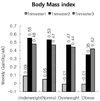Abstract
Objective
To examine the pattern of gestational weight gain using maternal characteristics and pregnancy outcomes.
Methods
We used maternal weight data from 1,825 women who had noncomplicated pregnancy between Jan. 2002 and Aug. 2009. The rate of maternal weight gain in each trimester, the associations between gestational weight gain per trimester and maternal characteristics and pregnancy outcomes, and the relationship between maternal characteristics and trimester weight gain were analyzed.
Results
The average rate of weight gain (kg/week) was lowest during the first trimester (0.06±0.30), peaked during the second trimester (0.52±0.23), and slowed slightly in the third trimester (0.47±0.23). With the exception of infant sex, all six maternal characteristics and pregnancy outcomes included in the multivariate analyses (parity, maternal age, height, BMI, preeclampsia, gestational DM) were associated significantly with maternal weight gain in at least one trimester. The important maternal predictors of weight gain per trimester were prepregnancy BMI, height and age in the first trimester; prepregnacy BMI, parity and height in the second; and height, age and parity in the third.
References
2. Brown JE, Murtaugh MA, Jacobs DR Jr, Margellos HC. Variation in newborn size according to pregnancy weight change by trimester. Am J Clin Nutr. 2002. 76:205–209.
3. National Academy of Sciences. Institute of Medicine. Food and Nutrition Board. Subcommittee on Nutritional Status and Weight Gain During Pregnancy. Nutrition during pregnancy. 1990. Washington, D.C.: National Academy Press.
4. American College of Obstetricians and Gynecologists. Nutrition during pregnancy. 1993. Washington: American College of Obstetricians and Gynecologists;Technical Bulletin no 179.
8. Abrams B, Carmichael S, Selvin S. Factors associated with the pattern of maternal weight gain during pregnancy. Obstet Gynecol. 1995. 86:170–176.
10. Hickey CA, Cliver SP, McNeal SF, Hoffman HJ, Goldenberg RL. Prenatal weight gain patterns and birth weight among nonobese black and white women. Obstet Gynecol. 1996. 88(4 Pt 1):490–496.
11. Caulfield LE, Witter FR, Stoltzfus RJ. Determination of gestational weight gain outside the recommended ranges among black and white women. Obstet Gynecol. 1996. 87(5 Pt 1):760–766.
12. Hediger M, Scholl T, Ances I, Belsky DH, Salmon R. Rate and amount of weight gain during adolescent pregnancy: Associations with maternal weight-for-height and birth weight. Am J Clin Nutr. 1990. 52:793–799.




 PDF
PDF ePub
ePub Citation
Citation Print
Print








 XML Download
XML Download